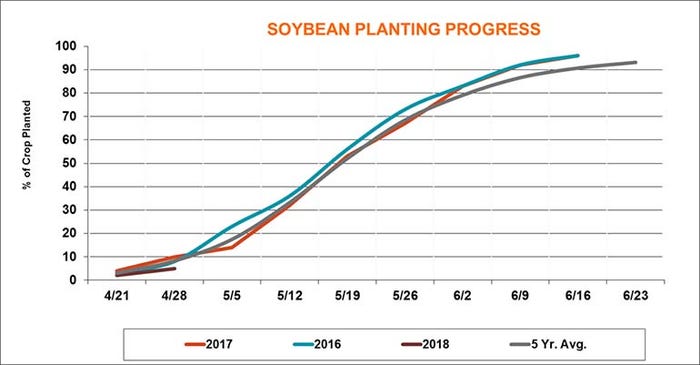
Corn planters have been rolling this past week – but how much progress did they make? According to the latest reports from USDA, 17% of the crop is now in the ground. That’s a modest jump from the prior week’s total of 5%, but planting progress remains slower than typical for now.

That’s about in line with trade analyst expectations. A recent survey by 14 industry analysts – including Farm Futures – estimated on average that 18% of the corn crop had been planted as of April 29. Farm Futures’ estimate was also 18%.

State to state, results were uneven, with three southern states leading the way with over half of their planting complete, including Texas (70%), North Carolina (63%) and Missouri (52%). Other states aren’t as far along, but some have made tremendous progress, such as Illinois (moving from 4% complete a week ago to 32%) and Iowa (moving from virtually 0% up to 17% complete).
Across the 18 top production states, only 3% of the corn crop is emerged at this time.


Soybean planting progress, at 5%, is more in line with the five-year average (also 5%), but a bit behind the pace from a year ago (9%). Louisiana (40%), Mississippi (35%) and Arkansas (26%) have made the most planting progress at this time. Industry analysts expected a planting progress to be a bit further along, with an average guess of 7%, meantime, although Farm Futures’ estimate of 5% was on the nose this week.


Spring wheat’s planting pace, on the other hand, is significantly behind normal, thanks in part to pervasively cold weather in Minnesota and the Dakotas that have kept relatively fewer planters rolling in those states. Total planting progress has reached 10%, versus 30% a year ago and a five-year average of 36%. It was also even slower than industry analysts expected, offering an average guess of 13%.
Winter wheat’s progress continues to move slowly toward heading, with 19% of the crop reaching that stage last week, versus the prior week’s total of 13%. Last year, 41% of the crop reached heading by the end of April; the five-year average is 30%.


USDA suggests winter wheat crop conditions are slightly improved from a week ago, rating 26% of the crop in good condition and another 7% of the crop in excellent condition. Last week, the agency labeled 25% of the crop in good condition and 6% of it in excellent condition.
Cotton planting has reached 12% as of April 29, not making much progress over the past week (planting was 10% complete as of April 22), but staying close to last year’s pace and the five-year average, both of which are 14%. Sorghum planting (26%) is also right in line with last year’s pace (27%) and the five-year average (26%).
Click here to see more state-by-state analysis as well as USDA’s planting progress for other crops such as peanuts, rice, oats and barley.
About the Author(s)
You May Also Like






